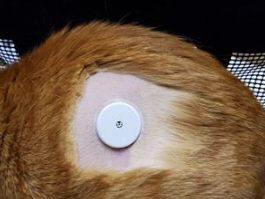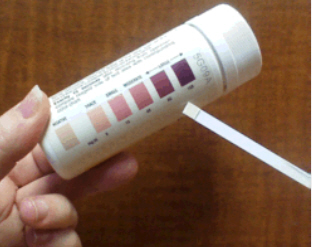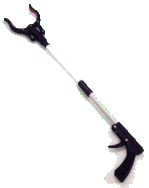Monitoring is crucial to determining your pet’s proper insulin dose. Much monitoring can be done at home, and it is possible to save a great deal of money by doing so; however, some tests simply must be done at the veterinarian’s office. Different tests complement each other so expect to be an active participant in the monitoring process.
If you will be monitoring glucose levels at home, be sure to ask your veterinarian what the minimum glucose level for skipping an insulin dose should be for your pet. If the glucose starts low, it will get even lower (and possibly too low) if you give more insulin.
Monitoring at Home
There are three ways to participate:
- Continuous monitoring technology
- Glucometer
- Urine dipstick monitoring
You may end up using all three methods and don't forget the importance of simply watching how your pet feels in general. Is there excess thirst? Is there an excess appetite? Is a healthy weight being maintained?
Continuous Monitoring: The FreeStyle Libre Device
The FreeStyle Libre device is a human glucose monitoring system that can be adapted to dogs and cats easily. For pets, a spot is shaved, usually on the shoulder or flank, and a round glucose sensor is implanted such that the sensor monitors tissue glucose levels. A scanner is provided (or you can use your cell phone) which can wirelessly communicate with the sensor. In this way, glucose can be checked simply by scanning the pet, and no blood collection is needed. The sensor must be replaced every two weeks (generally done at the vet's office as shaving the skin is involved). The kit and sensors can be obtained from most human pharmacies. Your veterinarian must prescribe the system for you.
FreeStyle Libre Feline

Orange tabby cat wearing a FreeStyle Libre device. Photo by MarVista Vet
Once data has been scanned, it is displayed on the LibreView website, and your veterinarian can check glucose level patterns throughout the day from any computer.
Advantages of this method:
- The pet does not have to go to the vet's office for glucose sampling. Going to the vet is stressful and can alter glucose levels. When the data is obtained at home, a more accurate record is obtained.
- No blood sampling is needed. The device reads subcutaneous glucose levels (which technically lag behind blood sugar levels by 15 minutes, but this rarely comes into play.)
- You and your vet can view several consecutive days of data in one sitting. You will need to provide the times when insulin was given and when the pet was fed. These can be added to the computer portal.
Disadvantages of this method:
- Many pets will not tolerate the device and pull it off as soon as possible. A sweater or T-shirt may be needed to protect the device. While the device is capable of lasting 14 days on a patient, it is a rare patient that wears the device for the full 14-day period. A dislodged device cannot be re-implanted.
- The device is made for human use and humans do not have the extensive subcutaneous space that animals have. It is possible that the needle sensor will not be long enough to get accurate readings.
- Only one device can pair with the sensor. This can be a phone or a reader but not both. Make sure you have the device and scan regularly.
- Implantation can fail and you will have to get a new device. (It's smart to always have a spare.)
Some pet owners like their pet to always wear a Libre so they can check a glucose level at any time and some only use it when a set of curves is needed (after an insulin dose changes, after a change in the patient's status).
This continuous monitor has changed the way diabetes mellitus is monitored and its use is strongly encouraged.
The Glucometer and Lancets
In a more traditional form of monitoring, a glucometer can be used to monitor pet glucose levels at home. This involves obtaining a small blood sample with a lancet device and doing so on a regular basis. Not every owner is able to accomplish this feat and not every pet is amenable to the process, but many people and many pets are perfectly fine with it.
In the past, human glucometers were used to monitor dog and cat blood sugars. The problem with doing this is that accuracy at higher values was not reliable. Trends were easy to see but more precise measurements were not possible to obtain. Today, there are several veterinary glucometers on the market, and we recommend buying one of these for best results. (The Alpahtrak meter is often used, but there are many others.)
The meter will come as a kit and provides links to instructional videos from the manufacturer along with written/illustrated guides for use. Blood collection instructions are also included, though we have added some links here as well. A test strip is inserted in the meter and a drop of blood is touched to it. The glucose value is displayed in a few seconds.
Taking Blood: Watch it Done
Click here to see a video of a cat having a suitable blood sample drawn (provided by Dr. Margie Wilson).
Most glucometers come in a kit that includes instruction discs, the meter, a control solution or similar calibration method, lancets to take your pet’s blood, and glucose sticks for the meter to read. In short, one assembles a dipstick in the meter and turns it on, punctures the pet’s ear or other area, and puts the stick in contact with the drop of blood that wells up. The meter does the rest.
Performing a Glucose Curve at Home
- Be sure to check glucose before feeding and before insulin is given. This is probably the most important glucose reading of the curve.
- Note the time of each glucose level, note the time of each feeding and the time the insulin is given.
- Check blood glucose levels every 2 hours until it is time for the next insulin level.
- At the end of the curve, provide the information to your veterinarian so that insulin dosing adjustments can be made.
Advantages of this Method:
- An implanted device that lasts only 2 weeks is not needed. You can pick up your meter and lancets any time and get your pet's glucose level. You can do spot checks or you can obtain full curves.
Disadvantages of this Method:
- You have to take your pet's blood in order to get a reading. This is not always simple.
- You will need to replenish your supply of test strips periodically.
- The meter will require some period maintenance and calibration which you will need to do.
- You will need to keep your own record of glucose levels. Here are some helpful resources on that:
A printable Monitoring Diary visit (PDF format) is available for download, here.
Urine Monitoring for Ketones
What are Ketones?
Everyone knows that food provides our bodies with fuel. Most of our tissues can burn stored fat, though our brains (and a few other tissues) have no use for fat and must burn glucose. In normal life, there is plenty of glucose to feed our brains and plenty of fat to feed the rest of our bodies and our metabolism runs happily along but in times of starvation problems start: we deplete stored glucose and we burn fat rapidly and desperately.
Ketones are a by-product of intense fat burning. The brain is able to use ketones as an alternative to glucose which is a good thing. The problem is that intense ketone production leads to metabolic pH changes leading to acidic blood and dangerous electrolyte imbalances.
When diabetes mellitus is complicated by infection or other problems, ketoacidosis can result. This is a very serious complication that can lead to expensive hospitalization and even death. It is helpful to monitor your pet’s urine for the presence of ketones.
Urine Ketone Monitoring
Ketostix_MVista

Ketostix can be purchased at any drugstore. Photo courtesy of MarVista Vet
Ketostix are urine dipsticks that indicate the presence of ketones in urine. Only a drop of urine is needed. Dip the ketostick in the urine and look for a color change. A color guide is present on the bottle of dipsticks. This need not be done every day if the pet seems to be doing well but when it is done record the results in the monitoring notebook if you have one.
Urine dipsticks to detect ketones are available at most drug stores and can be used for home monitoring. The presence of ketones in urine for three days or more in a row warrants a visit to the veterinarian.
Occasional ketones are not an alarming finding in a diabetic pet but if ketones are found in urine three days in a row or if the patient showing ketones seems ill (poor appetite, vomiting, etc.) then the pet should see the vet right away. In such a situation, diabetic ketoacidosis is likely occurring and serious treatment is likely needed.
Collecting Your Pet's Urine
Using Ketostix is simple enough, but one will need a sample of the pet’s urine. For dogs, this is best done as a two-person job.
Grabber reacher tool_MarVista

"Grabber-reacher" tool. Photo courtesy of MarVista Vet
Male Dogs
A male dog’s urine can be collected on a walk using a cup. The male dog is walked and when he lifts his leg to urinate, the second person simply catches the urine in the cup. This can be done with one person with some practice. It may be helpful to bend a metal coat hanger so that it can hold a paper cup on one end and have a long handle on the other end or invest in a “grabber reacher” as shown below to hold the cup. Alternatively, urine collection devices (basically a large spoon on an extendable handle) are available.
Female Dogs
A female dog is a bit trickier, and one may need a second person to slip a small paper plate under the dog as she urinates. Again, it is helpful if a second person manipulates the plate and uses the ketostick so that the person holding the leash does not have to manage all these tasks at once. If only one person is available, the “grabber reacher” shown above or a urine collection device may be helpful.
Cats
For cats, a piece of cellophane can be placed over the litter box and some urine will be caught there even if the cat digs in the box. Only a drop of urine is needed for the test so even if the cellophane is wrinkled up hopefully a drop can still be obtained. Alternatively, a very small amount of litter can be placed in the box. The cat will still understand what he or she is supposed to do but not all the urine will be absorbed by the litter.
It is not necessary or particularly even desirable to monitor urine glucose with dipsticks. The contents of the urinary bladder represent several hours of urine production, thus making the interpretation of urine glucose challenging. In the past, urine glucose monitoring has been recommended and certainly, there is nothing wrong with collecting more information. However, it can be confusing to decipher and should be considered optional.
Monitoring at the Hospital
Now that we've covered home monitoring, it is important to realize that some tests will simply be needed at the vet's office. Your vet will need to check in on how your pet is doing. Weight will be checked. The state of oral health will be reviewed as diabetic pets especially need clean teeth to minimize the seeding of other organs with bacteria.
Expect the following tests:
- A basic blood panel to see how other organs are doing.
- A urinalysis and culture as diabetic pets are highly prone to urinary tract infections.
- A fructosamine level that checks the average blood sugar levels over the last 2 weeks.
- A glucose curve if one cannot be provided from home.
Urinalysis and Urine Culture
It is largely inevitable that sugar will spill into your pet’s urine possibly even for a short time daily. Sugar in urine is highly encouraging to bacteria and urinary tract infections are common in diabetic pets. Often symptoms are difficult to discern at home so periodically performing urine cultures is a good practice in ruling out latent infection.
Learn more about urinary tract infections here.
Fructosamine Level
Measuring fructosamine is a helpful way to help monitor glucose control and, if for whatever reason, it is not possible to run glucose curves this would be the next best thing. Blood glucose fluctuations leave a metabolic mark that lasts a week or two. Measuring fructosamine gives a sense of the average blood glucose over the previous couple of weeks. Control is designated “excellent,” “good,” “fair,” “poor,” or “prolonged hypoglycemia.” Of course, because the fructosamine is looking at averages, it will not distinguish excellent control from wide swings from very high to very low glucose readings. Still, even with this limitation, fructosamine is good to include in periodic monitoring tests.
The Glucose Curve in the Animal Hospital
If your pet is not amenable to the Freestyle Libre device and not amenable to having blood sampling at home, a curve will likely be needed in the hospital. The curve is needed whenever there is a change in insulin dose or a change in your pet's status. This will be an all-day stay for your pet.
- Find out if you are to feed your pet first at home first. Some pets do not eat normally in the hospital which can alter the curve, but some veterinarians prefer you to bring the food with you and leave it with the pet. Definitely bring the pet's insulin and syringes as you will probably need to demonstrate your insulin administration technique.
- The veterinary staff will run a pre-insulin glucose level.
- After this is drawn, they will observe how you draw up and administer the insulin confirming that you are doing it correctly.
- The pet is then left with the food for the day and the veterinary staff will check blood glucose levels every 2 hours.
- Pick up your pet and receive new dosing instructions at the end of the day.
Remember, the numbers are not as important as how your pet is doing. We want your pet to lead as happy a life as possible free from excessive thirst, excessive hunger, secondary diseases, etc. Diabetes mellitus will require some home participation and good communication with your veterinarian in order for regulation to be achieved.